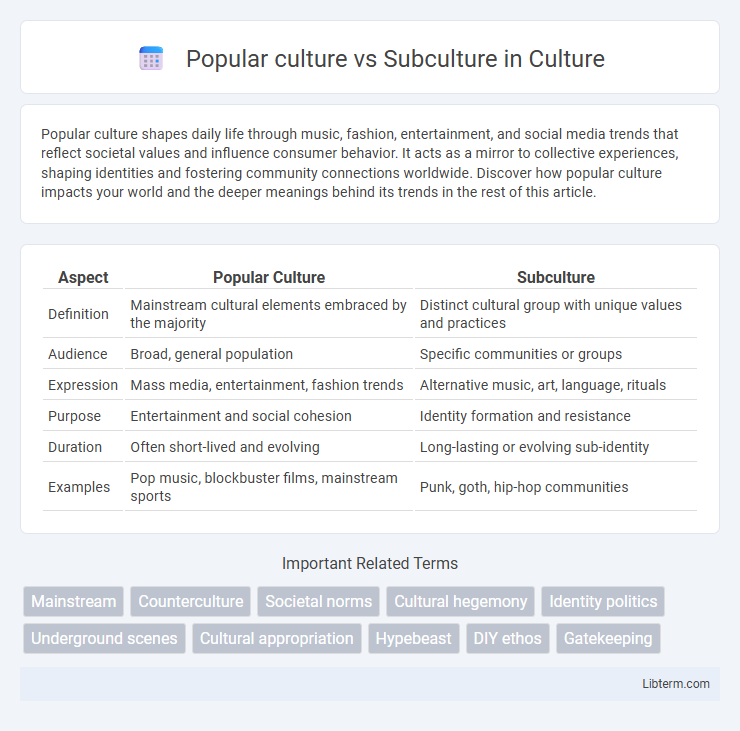Popular culture shapes daily life through music, fashion, entertainment, and social media trends that reflect societal values and influence consumer behavior. It acts as a mirror to collective experiences, shaping identities and fostering community connections worldwide. Discover how popular culture impacts your world and the deeper meanings behind its trends in the rest of this article.
Table of Comparison
| Aspect | Popular Culture | Subculture |
|---|---|---|
| Definition | Mainstream cultural elements embraced by the majority | Distinct cultural group with unique values and practices |
| Audience | Broad, general population | Specific communities or groups |
| Expression | Mass media, entertainment, fashion trends | Alternative music, art, language, rituals |
| Purpose | Entertainment and social cohesion | Identity formation and resistance |
| Duration | Often short-lived and evolving | Long-lasting or evolving sub-identity |
| Examples | Pop music, blockbuster films, mainstream sports | Punk, goth, hip-hop communities |
Defining Popular Culture: Characteristics and Influence
Popular culture encompasses widely shared practices, beliefs, and objects that dominate mainstream society, characterized by mass media dissemination and commercial appeal. It influences social norms by shaping lifestyles, language, fashion, and entertainment, reflecting collective experiences and values. The pervasive reach of popular culture drives consumer trends and impacts identity formation across diverse demographic groups.
What is Subculture? Origins and Unique Traits
Subculture refers to a distinct group within a larger culture that differentiates itself through unique beliefs, behaviors, values, and symbols. Originating from social, economic, or ethnic factors, subcultures often emerge as a response to mainstream cultural norms, creating alternative lifestyles or identities. Key traits include specialized language, fashion, rituals, and a strong sense of community that reinforce group identity and separate members from the dominant culture.
Historical Evolution of Popular Culture and Subcultures
The historical evolution of popular culture traces back to mass media's rise in the 19th and 20th centuries, consolidating shared practices, beliefs, and entertainment accessible to the general populace. In contrast, subcultures emerged as distinct social groups with unique values, styles, and norms, often reacting against mainstream cultural norms during periods of social change such as the post-war era or the 1960s counterculture movement. The continuous interaction between popular culture and subcultures shapes cultural diversity, innovation, and identity formation in contemporary society.
Major Differences: Popular Culture vs Subculture
Popular culture encompasses mainstream trends, widely accepted practices, and mass media phenomena that appeal to a broad audience, whereas subculture consists of distinct groups with unique values, behaviors, and norms that differentiate them from the dominant society. Popular culture often reflects societal norms and is disseminated through global platforms like television, film, and social media, while subcultures develop niche identities around specific interests, such as punk music, goth fashion, or veganism. The major difference lies in their scope and acceptance: popular culture is inclusive and commercially driven, whereas subculture is exclusive and countercultural.
How Subcultures Challenge Mainstream Norms
Subcultures challenge mainstream norms by creating distinct values, styles, and behaviors that resist or reinterpret dominant cultural narratives. They often employ alternative fashion, music, and language to express identity and dissent from popular culture's conventions. This oppositional stance fosters diversity and drives social change by questioning societal standards and promoting inclusivity.
Media’s Role in Shaping and Spreading Popular Culture
Media outlets such as television, social media platforms, and streaming services play a crucial role in shaping and spreading popular culture by rapidly disseminating trends, music, fashion, and language to global audiences. Popular culture, characterized by widespread appeal and mainstream consumption, contrasts with subcultures which develop distinctive styles and values often in response to or resistance against dominant media narratives. By amplifying certain cultural elements while marginalizing others, media influences the boundaries between popular culture and subculture, impacting social identities and group affiliations.
Subcultures that Became Mainstream Phenomena
Subcultures such as punk, hip-hop, and skateboarding have transitioned from niche communities into influential mainstream phenomena, shaping global fashion, music, and lifestyle trends. These subcultures often retain core elements while adapting to wider audiences, driving innovation and cultural diversity within popular culture. Their incorporation into mainstream media and commercial markets highlights an ongoing exchange between subcultural identity and mass appeal.
The Impact of Pop Culture and Subculture on Identity
Popular culture shapes collective identity by promoting widely shared values, trends, and symbols that influence mass behavior and social norms. Subcultures offer distinct identity frameworks, enabling members to resist mainstream narratives and express unique beliefs, styles, and practices. The dynamic interplay between pop culture and subcultures drives individual and group identity formation through negotiation of belonging and differentiation.
Conflicts and Interactions between Mainstream and Subcultures
Conflicts between popular culture and subcultures often arise due to differing values, norms, and expressions, with mainstream society sometimes perceiving subcultures as deviant or threatening. Interactions involve processes of appropriation, where elements of subcultures are absorbed and commercialized by popular culture, leading to both dilution and fierce resistance within subcultures. These dynamics underscore the ongoing negotiation of identity, power, and authenticity in cultural landscapes.
Future Trends: The Blurring Lines Between Pop Culture and Subculture
The future of cultural dynamics reveals an increasing convergence between popular culture and subcultures, driven by digital platforms and social media's role in amplifying niche identities. Emerging trends show subcultures influencing mainstream aesthetics and values, leading to hybrid cultural expressions that challenge traditional distinctions. This blurring of lines fosters a more inclusive cultural landscape where innovation arises from the intersection of diverse community-driven movements and mass media.
Popular culture Infographic

 libterm.com
libterm.com